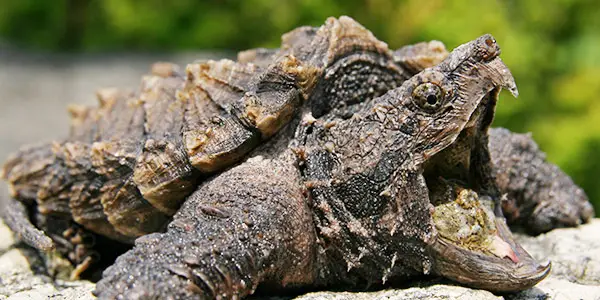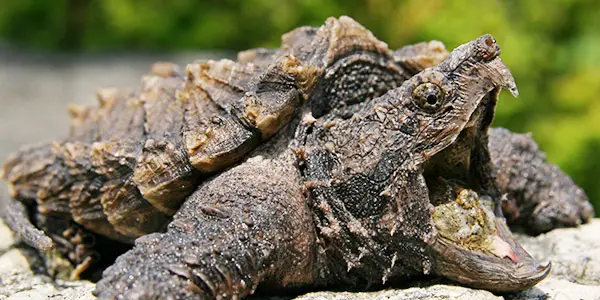Have you ever wondered what an alligator snapping turtle looks like? This fascinating creature is not only one of the largest freshwater turtles in the world but also one of the most unique-looking. With its massive head, sharp beak, and rough shell, the alligator snapping turtle is a sight to behold.
Often mistaken for a prehistoric relic, these turtles have a distinct appearance that sets them apart from other turtle species. From their long tails to their powerful jaws, the alligator snapping turtle is a true marvel of nature. So, let’s dive in and explore what makes this turtle so fascinating and what it looks like up close and personal.
An alligator snapping turtle has a large, muscular head with a pronounced hooked beak and a long, worm-like tongue used to lure prey. Its shell is dark brown with jagged ridges and a large, spiked tail. They can weigh up to 200 pounds and live up to 100 years.

What Does an Alligator Snapping Turtle Look Like?
Alligator snapping turtles are often called the dinosaurs of the turtle world because of their ancient appearance. These turtles are the largest freshwater turtles in North America, with a maximum weight of around 175 pounds. Here’s what you need to know about their appearance.
Head and Shell
The alligator snapping turtle has a large head, which is slightly pointed at the tip. Its eyes are small, and its nostrils are located at the end of its long snout. The turtle’s shell is thick and bumpy, with three distinct ridges along its back. The shell is often covered in algae and other aquatic plants, which helps the turtle blend into its environment.
The shell of the alligator snapping turtle can range in color from dark brown to black, and it’s covered in a series of spiky plates called scutes. The scutes are made of keratin, which is the same material that makes up human hair and nails. The scutes on the shell of the alligator snapping turtle are arranged in a specific pattern, which is unique to each individual turtle.
Size and Weight
Alligator snapping turtles are the largest freshwater turtles in North America, and they can grow to be quite large. The average size of an adult alligator snapping turtle is around 26 inches in length, although some individuals can grow to be much larger. The heaviest alligator snapping turtle on record weighed in at 249 pounds!
One of the most distinctive features of the alligator snapping turtle is its size and weight. These turtles are incredibly heavy and can be difficult to move, even for experienced handlers. Their size and weight make them formidable predators and help them defend themselves against potential threats.
Feet and Claws
The alligator snapping turtle has four feet, each of which has five toes with sharp claws. The front feet of the turtle are larger than the back feet, and they are used for grasping prey and holding onto objects in the water. The back feet are used primarily for swimming and steering.
The claws on the feet of the alligator snapping turtle are sharp and powerful, and they can cause serious injury to humans and other animals. It’s important to exercise caution when handling these turtles, as their claws can inflict a painful bite.
Benefits of Alligator Snapping Turtles
Alligator snapping turtles play an important role in their ecosystem, helping to maintain the balance of aquatic life. They are opportunistic feeders, meaning they will eat a variety of prey, including fish, frogs, snakes, and even other turtles. This helps to keep populations of these animals in check, preventing overpopulation and the depletion of resources.
In addition to their role as predators, alligator snapping turtles are also important indicators of the health of their environment. Because they are long-lived animals, they are particularly susceptible to changes in their environment, such as pollution and habitat destruction. By monitoring the health of alligator snapping turtle populations, scientists can gain valuable insights into the overall health of aquatic ecosystems.
Alligator Snapping Turtles vs. Common Snapping Turtles
Alligator snapping turtles are often confused with common snapping turtles, but there are some key differences between the two species. Alligator snapping turtles are much larger than common snapping turtles, and they have a more pronounced ridge along their back. Additionally, the head of the alligator snapping turtle is much larger and more pointed than that of the common snapping turtle.
Another key difference between the two species is their habitat. Alligator snapping turtles are primarily found in the southeastern United States, while common snapping turtles can be found throughout much of North America. Despite these differences, both species play important roles in their respective ecosystems and are fascinating animals to observe and learn about.
The Future of Alligator Snapping Turtles
Alligator snapping turtles are currently classified as a threatened species by the International Union for Conservation of Nature (IUCN). Habitat destruction, pollution, and over-harvesting for food and the pet trade have all contributed to the decline in alligator snapping turtle populations.
Conservation efforts are underway to protect alligator snapping turtles and their habitats. These efforts include habitat restoration, captive breeding programs, and public education campaigns aimed at raising awareness about the importance of these unique turtles. By working together, we can ensure that alligator snapping turtles continue to thrive in their natural habitats for generations to come.
Frequently Asked Questions
Find the answers to the most frequently asked questions about alligator snapping turtles below.
How big do alligator snapping turtles get?
Alligator snapping turtles are one of the largest freshwater turtles in the world. They can grow to be over 200 pounds and have a shell length of over two feet. Their head is large and has a hooked beak that helps them catch prey. Their skin is dark brown and has a textured appearance that helps them blend in with their surroundings.
Despite their large size, they are not very fast and rely on their camouflaged appearance to hide from predators and prey. They often spend most of their time buried in mud or sand, waiting for prey to come near them.
What is the habitat of alligator snapping turtles?
Alligator snapping turtles are found in the southeastern United States, primarily in the Mississippi River basin. They inhabit slow-moving rivers, lakes, and swamps. They prefer areas with a lot of vegetation and underwater hiding places, such as fallen logs or vegetation. They are most active during the night and spend most of their day resting underwater.
Due to habitat loss and overhunting, their population has declined significantly in recent years. It is important to protect their habitat and limit hunting to ensure their survival.
What do alligator snapping turtles eat?
Alligator snapping turtles are carnivores and eat a variety of prey. They primarily feed on fish, but also eat other aquatic animals such as frogs, snakes, and birds. They are known to lie motionless in the water with their mouth open, using their worm-like tongue to lure prey into their mouth. They have a strong bite and can easily crush the shells of their prey.
Because of their large size, alligator snapping turtles have few natural predators. However, they are hunted by humans for their meat and shell, which has led to a significant decline in their population.
How long do alligator snapping turtles live?
Alligator snapping turtles have a long lifespan and can live for over 100 years. Their slow metabolism and low activity level contribute to their longevity. They reach sexual maturity at around 11-13 years old and can continue to reproduce for many years after that.
Because of their long lifespan and slow reproductive rate, it is important to protect alligator snapping turtles from habitat loss and overhunting to ensure their survival.
Are alligator snapping turtles dangerous to humans?
Alligator snapping turtles are not generally considered a threat to humans, but they can be dangerous if provoked or handled incorrectly. Their large size and strong jaws can cause serious injury. It is important to give these animals their space and respect their habitats.
If you encounter an alligator snapping turtle in the wild, it is best to observe it from a distance and not approach it. If you must handle one, be sure to wear protective gloves and handle it with care to avoid injury to yourself or the turtle.
Alligator Snapping Turtle vs Common Snapping Turtle
In conclusion, the alligator snapping turtle is a fascinating creature that inhabits the waters of North America. Its unique appearance sets it apart from other turtles, with its large head, sharp beak, and rough, scaly skin. The alligator snapping turtle’s shell is also distinctive, with three prominent ridges running down its back.
Despite its intimidating appearance, the alligator snapping turtle is an important part of the ecosystem and plays a vital role in maintaining the balance of its habitat. Its powerful jaws and sharp beak help it to catch prey, and its large size makes it a formidable predator in the water.
If you ever come across an alligator snapping turtle in the wild, it’s important to give it plenty of space and respect its territory. These creatures are fascinating to observe from a distance, but they can be dangerous if provoked or threatened. So, enjoy the beauty of the alligator snapping turtle from afar and appreciate the important role it plays in the natural world.


